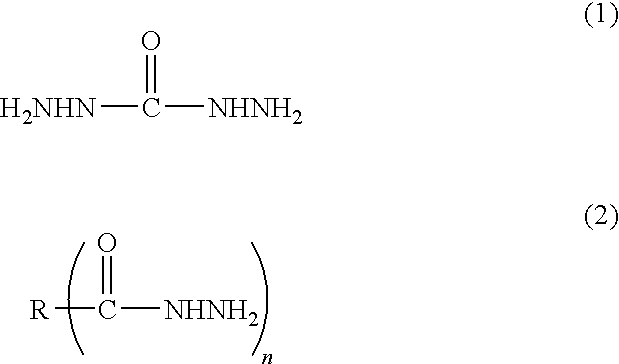Method for producing metal particle dispersion, conductive ink using metal particle dispersion produced by such method, and conductive coating film
a technology of metal particle dispersion and conductive coating, which is applied in the direction of non-conductive materials with dispersed conductive materials, chemical/physical processes, inks, etc., can solve the problems of increasing the difficulty of adjusting the reaction rate, difficult to obtain a favorable fine metal particle dispersion at good yield, and the demand for miniaturization of the circuit pattern. , to achieve the effect of preventing aggregation of fine metal particles, preventing aggregation, and rapid progress
- Summary
- Abstract
- Description
- Claims
- Application Information
AI Technical Summary
Benefits of technology
Problems solved by technology
Method used
Image
Examples
example 1
[0147]91.1 parts of toluene and 3.2 parts of a pigment dispersant, Solsperse 32000 manufactured by Lubrizol Japan Corporation were charged into a separable four-necked flask equipped with a condenser tube, a thermometer, a nitrogen gas inlet tube and a stirrer under nitrogen gas and dissolved. Then, 73.1 parts of 20% aqueous succinic dihydrazide solution (2 mole times of hydrazide as much as that of metal) was added dropwise thereto at 50° C. while being stirred, to generate uniform droplets. 100 parts of 1 M aqueous silver nitrate solution was weighed and charged into a beaker, and then 27.3 parts of 25% aqueous ammonia (4 mole times as much as that of metal) was added dropwise thereto while being stirred. The aqueous ammonia complex solution obtained was added dropwise into the toluene solution above and allowed reaction at 30° C. After leaving the mixture and separating it into toluene phase and water phase, the aqueous phase was taken away to remove the excessive reducing agent ...
example 2
[0148]A dispersion of fine silver particles was prepared in the same manner as Example 1 except that the amount of the pigment dispersant was changed to 0.5 parts. The dispersion of fine silver particle obtained was flowable and had broad wavelength range absorption at 429 nm and had a silver concentration of 50%. The average particle diameter of the fine silver particles was 15±10 nm and the distribution of the silver particle was wide. The yield of the fine silver particle dispersion was 40%, and the average particle diameter of the fine silver particles became 50 nm after storage at 40° C. for one month.
example 3
[0149]A dispersion of fine silver particle was prepared in the same manner as Example 1 except that the amount of the 25% aqueous ammonia was changed to 40.9 parts (6 moles times as much as that of metal). The dispersion of fine silver particles obtained was flowable, and had a strong absorption at the wavelength of 416 nm and a silver concentration of 76%. The average particle diameter of the fine silver particles was 5±2 nm and the particle diameter of the fine silver particles was uniform. The yield of the fine silver particle dispersion was 85%, and the absorption wavelength of the fine silver particle dispersion and particle diameter of the fine silver particle were not changed even after storage at 40° C. for a month.
PUM
| Property | Measurement | Unit |
|---|---|---|
| temperature | aaaaa | aaaaa |
| temperature | aaaaa | aaaaa |
| temperature | aaaaa | aaaaa |
Abstract
Description
Claims
Application Information
 Login to View More
Login to View More - R&D
- Intellectual Property
- Life Sciences
- Materials
- Tech Scout
- Unparalleled Data Quality
- Higher Quality Content
- 60% Fewer Hallucinations
Browse by: Latest US Patents, China's latest patents, Technical Efficacy Thesaurus, Application Domain, Technology Topic, Popular Technical Reports.
© 2025 PatSnap. All rights reserved.Legal|Privacy policy|Modern Slavery Act Transparency Statement|Sitemap|About US| Contact US: help@patsnap.com



